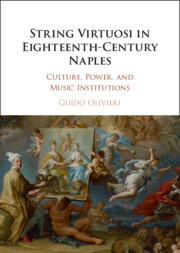Book contents
- String Virtuosi in Eighteenth-Century Naples
- String Virtuosi in Eighteenth-Century Naples
- Copyright page
- Dedication
- Contents
- Figures
- Tables
- Music Examples
- Acknowledgments
- Introduction
- 1 Music Institutions in Naples
- 2 The Formation of the Neapolitan String Virtuosi
- 3 Cello Virtuosi
- 4 Between Naples and Paris
- 5 Neapolitan Virtuosi in the Public Sphere
- 6 Neapolitan Instrumental Music under the Austrian Domination
- 7 Under the Wings of the Imperial Eagle
- Epilogue
- Bibliography
- Index
7 - Under the Wings of the Imperial Eagle
String Virtuosi between Naples and Vienna
Published online by Cambridge University Press: 13 January 2024
- String Virtuosi in Eighteenth-Century Naples
- String Virtuosi in Eighteenth-Century Naples
- Copyright page
- Dedication
- Contents
- Figures
- Tables
- Music Examples
- Acknowledgments
- Introduction
- 1 Music Institutions in Naples
- 2 The Formation of the Neapolitan String Virtuosi
- 3 Cello Virtuosi
- 4 Between Naples and Paris
- 5 Neapolitan Virtuosi in the Public Sphere
- 6 Neapolitan Instrumental Music under the Austrian Domination
- 7 Under the Wings of the Imperial Eagle
- Epilogue
- Bibliography
- Index
Summary
The rapidly changing political landscape of the Neapolitan Viceregno had a significant impact on the professional path of artists and musicians. Driven by a growing awareness of their central place in artistic culture, the Neapolitan string virtuosi became in many cases cultural agents who played an active role in endorsing and shaping the political and cultural programs of dynastic powers. The career of violinist Angelo Ragazzi is emblematic of the close cultural and artistic networks established between the Neapolitan and Viennese courts and illustrates the musicians’ negotiations with political powers. Ragazzi’s sonatas offer a privileged viewpoint from which to investigate the blending of “old” contrapuntal and “modern” concertante styles. In the first quarter of the eighteenth century, the proliferation in Naples of sonatas for three violins and continuo, characterized by marked contrapuntal language, derives in part from the influence of the Viennese contrapuntal style. The sonatas for three violins published by Giuseppe Antonio Avitrano appears as a unique case of printed instrumental music in Naples, realized thanks to influential aristocratic patronage, in a market that suffered from the absence of a significant middle-class amateur performers.
Keywords
- Type
- Chapter
- Information
- String Virtuosi in Eighteenth-Century NaplesCulture, Power, and Music Institutions, pp. 205 - 235Publisher: Cambridge University PressPrint publication year: 2023



